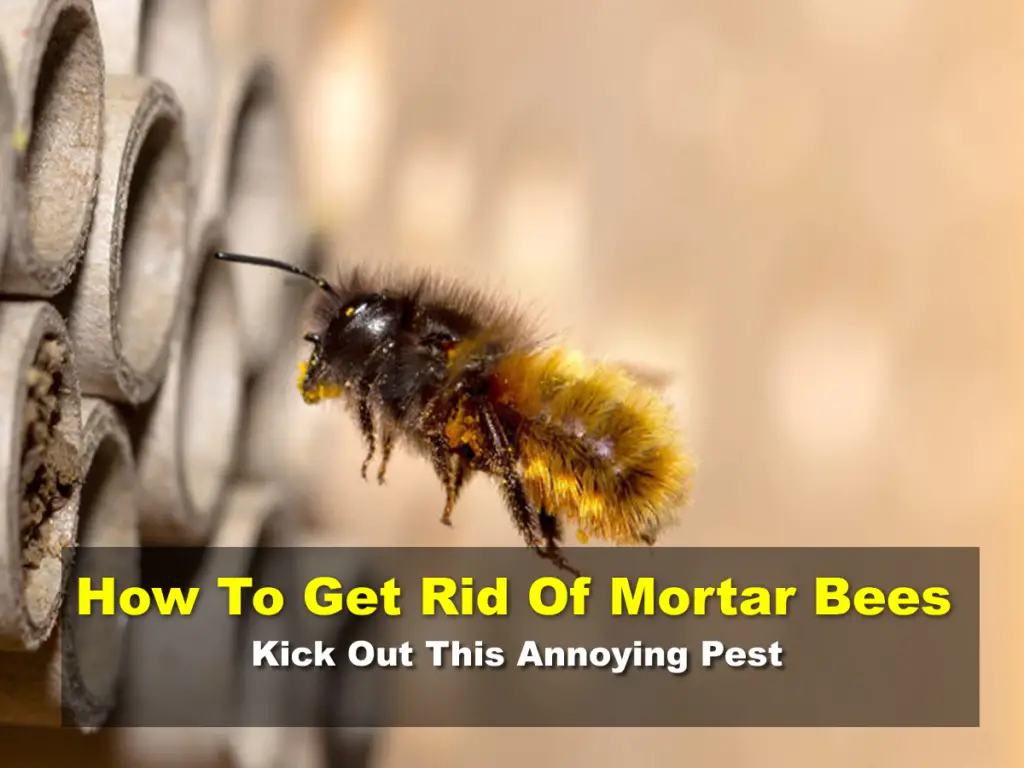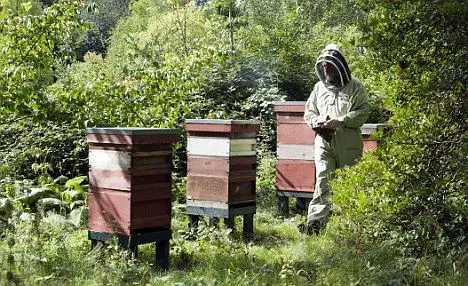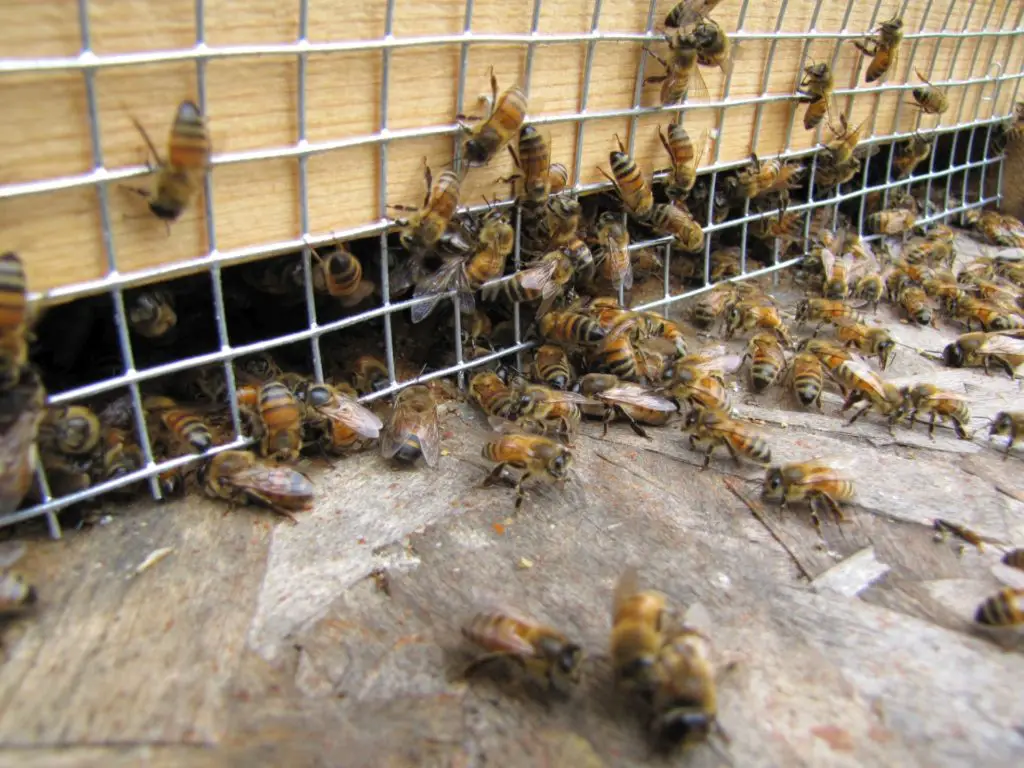Affiliate Disclaimer - As an Amazon Associate I earn from qualifying purchases.
It supports the website. So, Thank you
Mortar bees, sometimes called masonry bees, are known for nesting in holes and cavities around your home. While they are not dangerous to humans, they are considered to be a pest so if you’ve got them around your property, you’re probably wondering how to get rid of mortar bees.
Before taking any other action, natural methods like using essential oils or vinegar are preferred. Mortar bees are pollinators so should only be killed as a last ditch effort.
Often, prevention is better than cure so, in this guide, I’ll not only tell you about some effective methods of ridding your property of these bees but also offer some advice on how to stop them returning.
Table of Contents
What Are Mortar Bees?
Mortar bees or masonry bees come from the Megachilidae family of bees in a genus known as Osmia. There are several species within this family including the orchard mortar bee and the red mortar bee.
While these bees are seen to be something of a nuisance, there’s no denying that they’re beautiful with their often metallic coloration and striking appearance. Compared to something like the honey bee, mortar bees are notably smaller. Their size is an evolutionary result of the need to fit into small holes.
One of the reasons that mortar bees are considered to be such a pest is that they nest in cavities within a property. This can include holes in bricks and even wood as well as openings created from screws and nails.
Normally, mortar bees make an appearance in the spring and will continue to appear around your property until the end of summer.
Are Mortar Bees Dangerous?
Like many species of bees, mortar bees have a sting. However, it’s only the females that are equipped with this method of self defense. Moreover, mortar bees are highly unlikely to sting and are known for their incredibly passive temperament.
It’s often reported that this species of bee will quite happily coexist with humans, causing little to no threat. That said, it is worth keeping in mind that, like any bee species, mortar bees will sting when they are threatened or afraid.
In terms of your property, it’s more good news. Since mortar bees typically inhabit existing holes and crevices, they’re very unlikely to bore into your home and cause any damage.
How To Get Rid Of Mortar Bees Humanely
As I mentioned earlier, mortar bees are important pollinators. This is the case with all bee species and, without them, our crops and wildflowers would struggle to reproduce.
For this reason, it’s always advisable to remove any species of bee from your home or back yard using natural methods, where possible.
Below, I’ve listed some ideas on how to humanely get rid of mortar bees and I’d highly recommend trying these as a first port of call.
Repoint Cavities
Mortar bees can often be found nesting in cavities around your property. But if they cannot access their nest then they’ll move on.
Filling in any holes is an excellent way to deter them and encourage them to leave. However, it is important to keep in mind that your mortar should be strong enough that the bees won’t be able to burrow back through it.
The good news is that mortar bees are only able to bore through relatively weak materials so this does make life easier. That said, you must also consider that this could be time consuming work if there are a lot of holes to fill.
Essential Oils
Essential oils are fantastic for a number of things, including getting rid of mortar (and other types of) bees. Of course, you have to choose the right ones if they’re going to work as a deterrent but things like citronella, eucalyptus, lime, and lemon all work wonders.
Simply mix a few drops of your chosen essential oil with some water in a spray bottle. Then apply the solution to the nests. You may need to make a few applications before all of the bees take their leave but this is an ideal method for people that don’t want to cause any harm to their insect visitors.
This is also a good option if you want to ensure that all bees are out of the nest before filling in the holes.
Vinegar
If there’s one thing that bees hate the smell of, it’s vinegar. And the great thing is that most of us already have it in our pantry.
As is the case with essential oils, you’ll need to mix the vinegar with some water. This time, however, a few drops won’t cut the mustard; you’ll need to mix equal parts of both liquids for the greatest effect.
Again, add the solution to a spray bottle and go to town on the nest. It can also be helpful to spray any plants or flowers that the bees have taken an interest in to prevent them from hanging around.
Spearmint Plants
When most people think of bees, they imagine flowers and plants. Yes, it’s true that bees do pollinate and collect resources from a variety of plants. However, there are some that they’d rather steer clear from.
Spearmint is a wonderful addition to your garden because it can be used for a number of things like creating a natural home fragrance and in cooking. But it’s also perfect for deterring mortar bees who can’t stand the smell.
Plant some spearmint around the nest sites as well as around other plants in your garden that the bees have shown interest in. The smell alone will cause them to fly in the opposite direction. Plus, this method is 100% natural and causes the bees no harm.
What To Do If All Else Fails
I am an advocate for using natural methods to get rid of mortar bees but I also have to be realistic. In some cases, these bee-friendly methods just don’t work, especially where there are several nests or a large number of bees. In some cases, the bees may simply be stubborn.
Whatever the case, if natural methods haven’t worked and you’re still playing host to mortar bees then you may need to step it up to the next level and use chemicals.
You’ll need to use an insecticide treatment that contains an ingredient called pyrethrins. This will effectively kill all and any bees within the nest.
In order to make sure that you get rid of as many as possible, I would recommend treating the nest either first thing in the morning or at dusk. During these hours, the bees are more likely to be inside the nest as they typically don’t like to fly in cooler temperatures.
Apply the insecticide according to the pack instructions and wait for the recommended time before taking any further action.
It’s essential that, when dealing with bees, you wear protective clothing and keep children and pets well clear of the area. Even though mortar bees are generally a placid species, they will sting if they are touched, squeezed, or when they’re in danger.
If you don’t feel comfortable treating the nest yourself, that’s completely understandable. The good news is that there are many pest control specialists on hand to help. Yes, this can be more costly than simply purchasing an insecticide from your local hardware or garden store but you can feel confident that these professionals will get the job done.
Preventing Mortar Bees
Once you have successfully rid your home of mortar bees, I’m sure you’ll want to keep them at bay in future. So, for this reason, the work isn’t over just yet.
As I mentioned earlier, filling in holes is a great way to stop mortar bees from getting in. If you didn’t complete this step earlier, it’s time to do it now. Inspect your home for any crevices, cracks, or holes and fill these in using the appropriate material.
Keep in mind that, while they are called mortar bees, this species doesn’t limit its nesting locations to bricks. They will also hide out in cavities in wood, window frames and other areas around the home. This is why it’s important to check all areas and address any issues as you find them.
If you’re filling in holes with soft mortar then it may be a good idea to first cover the opening with some fine mesh. In the event that bees are able to burrow through, they’ll be met with another barrier. During the spring, it may also be wise to cover problem areas with netting as this will again make it more difficult for mortar bees to locate a suitable nesting spot.
Some people like to mix liquid insecticide with their filling material but you should keep in mind that this is harmful to the bees. So, if you’re keen to go all-natural, this might not be the right method of prevention for you.
Earlier, I talked about the use of spearmint to deter mortar bees but this isn’t the only plant that will send them packing. An excellent natural way to prevent these bees (and other bee species) from coming back is to reconsider what you’re planting in your garden.
You’ll want to avoid things like black-eyed Susan, lavender, and forget-me-nots as these are highly attractive to mortar bees. But filling your garden with fragrant herbaceous plants like neem, cloves, citronella, and eucalyptus can work wonders in preventing future flying visitors.
Final Thoughts
Mortar bees are a small, harmless species that often live near humans. While they don’t pose a threat, having large numbers of them around your property can be a nuisance. For this reason, many homeowners are looking for ideas on how to get rid of mortar bees.
The great news is that there are some very effective natural methods although some require repeated applications and something of a time investment.
There are also chemical options although I’d only recommend these in the most severe circumstances. Mortar bees play an important role as pollinators so, where possible, we should protect them and treat them humanely.




